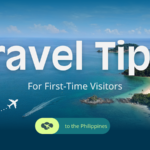The Philippines is a vibrant archipelago of over 7,000 islands, known for its natural beauty, welcoming people, and rich culture. As exciting as it is, navigating the country can be overwhelming if it’s your first visit. This Travel Guide to Philippines offers everything you need to make your trip seamless, safe, and full of unforgettable memories. Whether you’re planning to explore bustling cities, serene beaches, or remote provinces, these First-Time Visitor Tips in Philippines will help you enjoy your journey like a seasoned traveler.
1. Know the Best Time to Visit
The Philippines has a tropical climate with two main seasons—dry season (November to May) and wet season (June to October). The dry season is the most popular for tourists, especially between December and April.
Travel Tip:
If you’re planning island-hopping or diving adventures, aim for March to May when seas are calmer and skies are clearer.
2. Understand Entry Requirements
Most nationalities, including citizens from the US, UK, EU, Australia, and many Asian countries, can enter the Philippines visa-free for up to 30 days. Ensure your passport is valid for at least 6 months from the date of entry.
Travel Tip:
Have a return or onward ticket ready. Immigration officers may ask to see proof of exit from the country.
3. Choose the Right Destinations for Your Travel Style
The Philippines caters to every type of traveler. Choose based on your interests:
-
For beaches and water activities: Palawan, Boracay, and Siargao
-
For culture and history: Manila, Vigan, and Cebu
-
For nature and wildlife: Bohol, Davao, and Camiguin
Travel Tip:
Avoid overpacking your itinerary. Traveling between islands can be time-consuming. Focus on 2–3 destinations for a 2-week trip.
4. Transportation Tips Within the Country
Domestic travel often includes a combination of flights, ferries, and road trips. Book major flights in advance, especially during peak seasons.
Common transport options:
-
Jeepneys: Iconic and affordable for short city rides.
-
Tricycles and Motorbikes: Great for provincial travel.
-
Domestic Flights: Cebu Pacific, Philippine Airlines, and AirAsia offer extensive local routes.
Travel Tip:
Expect occasional delays and plan buffer time between connections.
5. Currency and Budgeting
The local currency is the Philippine Peso (PHP). Credit cards are accepted in urban areas, but rural islands are largely cash-based.
Travel Tip:
Withdraw pesos from ATMs at the airport or malls. Always carry small bills for local markets and transport.
6. Communication and Internet Access
English is widely spoken, especially in tourist zones. For communication and navigation:
-
Buy a local SIM card (Globe or Smart) at the airport.
-
Pocket Wi-Fi devices are available for rent.
Travel Tip:
Download offline maps and a translation app before your trip for convenience in more remote areas.
7. Safety and Health Precautions
The Philippines is generally safe, but like any travel destination, common-sense precautions apply:
-
Avoid isolated areas after dark.
-
Keep valuables secure and avoid flashy jewelry.
-
Drink bottled or filtered water.
Travel Tip:
Consult your doctor for recommended vaccinations. Bring sunscreen, insect repellent, and a basic first-aid kit.
8. Cultural Etiquette and Social Norms
Filipinos are known for their warmth and hospitality. Respect for elders, politeness, and modest dress in rural areas are appreciated.
Helpful phrases to learn:
-
“Salamat” – Thank you
-
“Magandang araw” – Good day
-
“Paumanhin” – Excuse me / Sorry
Travel Tip:
Remove shoes when entering homes and some accommodations. Always greet with a smile—it goes a long way.
9. Food and Dietary Tips
Filipino cuisine is flavorful and diverse. Try local dishes like adobo, sinigang, lechon, and halo-halo for dessert. Street food is tempting, but choose clean vendors to avoid stomach issues.
Travel Tip:
If you have dietary restrictions, let your hosts or restaurants know. Vegan and vegetarian options are limited in some areas but available in major cities.
10. Connectivity and Power Outlets
The Philippines uses Type A, B, and C electrical outlets. Voltage is 220V.
Travel Tip:
Bring a universal travel adapter and a power bank, especially when visiting islands with limited electricity access.
11. Respect the Environment
Many of the Philippines’ best attractions are its natural wonders. Support eco-tourism by respecting wildlife, using reef-safe sunscreen, and not littering.
Travel Tip:
Participate in beach clean-ups or stay in eco-resorts that actively protect the environment.
12. Emergency Numbers and Useful Apps
Emergency Numbers:
-
911 – General Emergency
-
117 – Philippine National Police
Useful Apps:
-
Grab (for transport in major cities)
-
Klook (for tours and activities)
-
Google Translate (for local dialects)
Travel Tip:
Take a photo of your passport, visa, and travel insurance. Store it online in case of loss.
Final Thoughts
With stunning natural landscapes, fascinating culture, and warm hospitality, the Philippines is an extraordinary destination. This Travel Guide to Philippines equips you with essential First-Time Visitor Tips in Philippines to make the most of your journey. From pristine beaches to vibrant cities, every moment spent here will leave you wanting more.

